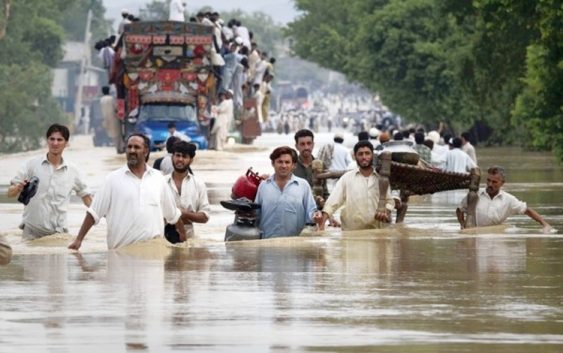Global warming is expected to unleash more rain, exposing millions of more people to river flooding particularly in the United States and parts of Asia, Africa and central Europe, researchers said Wednesday
Pakistan to observe doubling in high-end flood risk by 2040
The study in the journal Science Advances calculates how much more flood protection will be needed to keep the risks of high-end floods constant in the next 25 years.
Unless actions are taken – such as enhancing dykes, boosting building standards, relocating settlements and managing rivers – the number of people affected by devastating floods could skyrocket, warns the report, based on models that are 10 times more precise than commonly used climate computer simulations.

Asia – the continent with the largest historical high-end flood risk – would get hit the hardest, with the number of people affected by river flooding projected to go from 70 to 156 million by 2040, it said.
For instance, Pakistan, already prone to flooding, “will observe almost a doubling in high-end flood risk,” with 11 million people at risk of floods unless protective measures are taken by 2040.
“In South America, the number of people affected by flooding risks will likely increase from six to 12 million, in Africa from 25 to 34 million,” it added.
In Germany the number of people affected is projected to rise sevenfold, from 100,000 to 700,000.
In North America, it could rise from 100,000 to one million.
“More than half of the United States must at least double their protection level within the next two decades if they want to avoid a dramatic increase in river flood risks,” said lead author Sven Willner from the Potsdam Institute for Climate Impact Research (PIK).
The increase in river flood risks over the next few decades is being driven by the number of greenhouse gases already emitted into the atmosphere by the burning of fossil fuels.
When more heat-trapping pollutants surround the Earth, more moisture is held in the air, leading to more rainfall.
Cutting these emissions is crucial to reducing flood risks for future generations.
Related posts:
 10 Most Beautiful Mosques (Masjids) in the World
10 Most Beautiful Mosques (Masjids) in the World
 13 Most Delicious Desi Food Items From Lahore
13 Most Delicious Desi Food Items From Lahore
 Shandur Lake of Gilgit, Baltistan, Pakistan
Shandur Lake of Gilgit, Baltistan, Pakistan
 10 of the Most Haunted or Mysterious Places of Pakistan
10 of the Most Haunted or Mysterious Places of Pakistan
 Now You Can Get Rickshaw In Karachi Online!
Now You Can Get Rickshaw In Karachi Online!
 Karachi Teacher Beating Little Children, Puts one in ICU!
Karachi Teacher Beating Little Children, Puts one in ICU!
 Iqra University North Campus, An Another Milestone!
Iqra University North Campus, An Another Milestone!
 Salman Ahmed – An Underrated Muscleman From Lahore
Salman Ahmed – An Underrated Muscleman From Lahore
 Qandeel Baloch Killed By Her Brother in Multan
Qandeel Baloch Killed By Her Brother in Multan
 What is History of 14 August and Why Pakistani’s Celebrate it
What is History of 14 August and Why Pakistani’s Celebrate it
 Zong Has Shown Interest in Buying PTCL and Ufone
Zong Has Shown Interest in Buying PTCL and Ufone
 Indian Movies Banned in Pakistani Cinemas
Indian Movies Banned in Pakistani Cinemas


